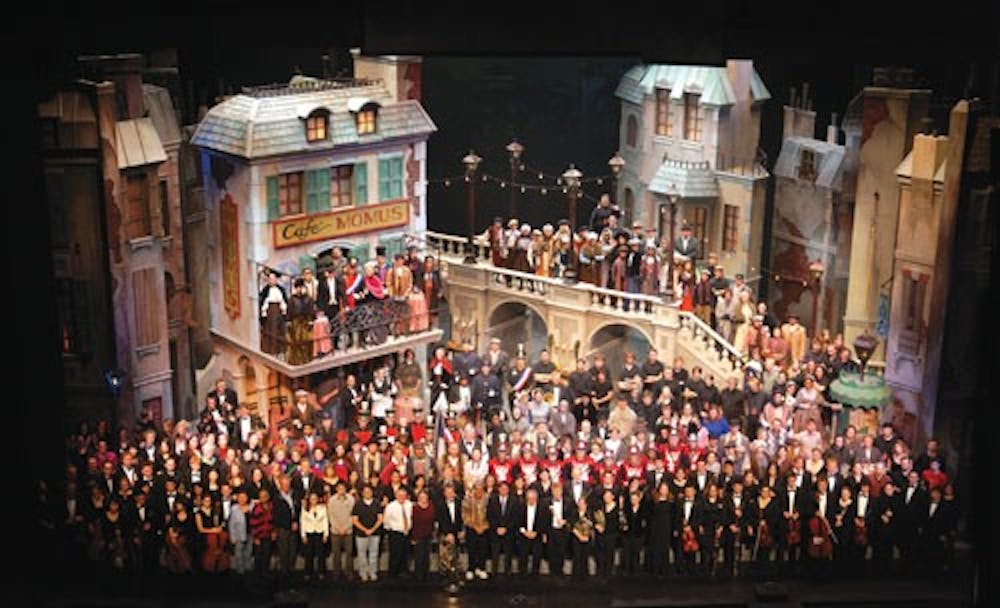For 100 years, one opera has been fantastically popular and considered an essential part of any opera house’s repertoire – Giacomo Puccini’s “La Bohème.” Exactly a century after the 1896 debut of the opera, a rock musical based off the characters and events was reinvented for the Broadway stage, and has since enjoyed the same amount of notoriety and controversy. \nThese two renowned shows graced the stages of IU in the same week: “La Bohème” at the Musical Arts Center and Jonathan Larson’s “Rent” at the IU Auditorium. “La Bohème” opened at the Musical Arts Center on Nov. 9 and is continuing this weekend. A national touring cast of “Rent” completed a two-day run in Bloomington Wednesday night. \nMost people know “Rent” is a Tony Award-winning musical, or at least they discovered that after the 2005 release of the movie. But what some might not know is how true “Rent” stays to its 19th \ncentury counterpart.\nThe story lines are startlingly similar – in “La Bohème,” which is set in the 1830s, Rodolfo, along with his roommates Colline, Schaunard and Marcello, occupy a small apartment in Paris. Rodolfo meets and falls in love with a woman named Mimi after she comes to his apartment when her candle goes out. Mimi is fighting tuberculosis and her health rapidly declines before her lover’s eyes. \nIn “Rent,” which is set in the early 1990s in New York City, the names are slightly altered; Rodolfo becomes Roger, Colline becomes Collins and Marcello becomes Mark. Tuberculosis is replaced with AIDS, which Mimi, Collins and Roger battled. Though the illness evolved to match the times, both diseases were similar in their prognosis. In the 1830s, tuberculosis had no cure, and in the 1990s, the AIDS epidemic was still somewhat of a mystery. \nWhile there are more main characters in “Rent,” as well as homosexual characters, the chain of events in both the 1896 and the 1996 shows are parallel. The love between Mimi and Rodolfo is the backbone for both the opera and the musical. Both works are romantic and exciting, and though “La Bohème” is sung in Italian, it’s easy to follow what is going on with the characters. English translations on a screen above the stage aid the audience. \nThe opening sets, which are two apartments, are conceptually similar. The set for “La Bohème” is remarkable because it can revolve 360 degrees. In Act One, it switches effortlessly from Rodolfo’s apartment to a street scene outside the Café Momus in Paris. During Friday’s performance, the change caused audience members to gasp in awe as the set pieces glided to the front of the stage as if by magic. \n“The new sets were incredible,” said Bloomington resident Pam Davidson, who attended “La Bohème” by herself and “Rent” with her \ndaughter, Olivia. \nOne of the biggest differences between the two shows is the music. Though hints of “La Bohème” shine through “Rent” in the song “La Vie Bohème” and Roger’s repeated playing of “Musetta’s Waltz” on his guitar, the music in “Rent” is much more modern and rock and roll than the opera. \nDavidson said she preferred “La Bohème” because of \nits music.\n“It’s so romantic,” she said. “With the opera, your voice really has to carry you through the songs.” \nShe said she was glad to be able to see both shows, and that though she couldn’t get her daughter to attend “La Bohème,” she was delighted to see “Rent” at the auditorium. \n“How lucky we are to live in Bloomington and have this opportunity,” she said. \n“La Bohème” will be at 8 p.m. Friday and Saturday at the Musical Arts Center. Tickets are $10 to $20 for students and $15 to $35 for adults. They can be purchased at the Musical Arts Center Box Office or through Ticketmaster.
La Bohème
A century is almost all that distinguishes the award-winning musical ‘Rent’ from Puccini’s 19th century opera La Bohème

Get stories like this in your inbox
Subscribe





